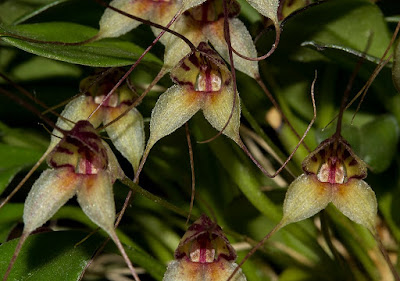Masdevallia nidifica is found in windy lower montane cloud forests at elevations of 450 to 2500 meters of Costa Rica, Panama, Colombia, Ecuador and Peru. It is a relatively common species with a wide range of distribution.
Masdevallia nidifica also called as The Nesting Masdevallia, Buccella nidifica, Masdevallia cyathogastra, Masdevallia tenuicauda, is a species of the genus Masdevallia. This species was described by Heinrich Gustav Reichenbach in 1878. The name of this species is derived from the Latin word nidificus, meaning to make a nest, which describes its caespitose habit.
IDENTIFY MASDEVALLIA NIDIFICA ORCHID PLANT
Masdevallia nidifica is found in windy lower montane cloud forests at elevations of 450 to 2500 meters of Costa Rica, Panama, Colombia, Ecuador and Peru. It is a relatively common species with a wide range of distribution.
It is a mini-miniature sized, warm to cold growing epiphytic species with short ramicauls enveloped basally by 2 to 3 close, tubular bracts and carrying a single, apical, elliptic-lanceolate, reddish green color leaf.
The Nesting Masdevallia blooms in the winter and summer from a solitary flowered, arcuate, 1.5 to 5 cm long, inflorescence arising from low on the ramicaul with the flower held at or above leaf level. Some variability occurs in color, size, and shape of the petals throughout this broad range, with larger forms found on the western slopes of Pichincha, Ecuador, while smaller forms are found in Central America. The more typical color form of the plant in cultivation is derived from the Central American populations and is known as Masdevallia nidifica var. alexandrae. The small maroon and white flowers, with long, wispy sepaline tails, bloom in the fall to winter and have a fragrance described by some as “herby.” A translucent yellow color form is known as Masdevallia nidifica var. ventricosa, and a white form is known as Masdevallia nidifica var. alba.
MASDEVALLIA NIDIFICA ORCHID PLANT CARE AND CULTURE
Cultural information should only be used as a guide, and should be to be adapted to suit you. Your physical location; where you grow your plants, how much time you have to devote to their care, and many other factors, will need to be taken into account. Only then can you decide on the cultural methods that best suit you and your plants.
Light:
Masdevallia nidifica like good light, but not direct light. 17000 - 22000 lux is a good amount of light. About 70-90% shade is recommended in summer and 25% shade to full sun in winter. It will flower better if receive plenty of light and leaves are pale green rather than dark green when in heavy shade.
Temperature:
The Nesting Masdevallia can be grown in intermediate to warm growing conditions from 13°C to 26°C. Temperatures consistently above 30°C will weaken the plants and they may drop their leaves. Ensure 6-12°C day/night difference to aid flower formation.
Humidity:
This orchid prefer high humidity in summer near 75-80% and may need a humidifier over summer. Keep air circulation at all times to prevent water staying on leaves as this will encourage leaf spot.
Substrate, growing media and repotting:
Masdevallia nidifica can be grown in basket or net pots. They can also be grown in pots or mounted. They prefer a continuously damp medium. Some growers use chopped sphagnum moss mixed with polystyrene chips. Others use a pine bark, polystyrene and coarse perlite mix. A mix of 5 parts bark, 5 parts perlite and 1 part fibrous, not fine, peat moss is recommended. Their roots are small and many and will fill pots very quickly when growing well. Deeper pots are generally used and plants are potted out from being divided into 5cm tubes, 7-10cm pots or 12-15cm pots depending on size.
Repot or divide the plants during the autumn or spring every two years or when they are sufficiently large enough. It is best, as with most plants, to repot when the plants are about to root to minimize disturbance. Huge clumps must be divided as a considerable number of species tend to completely rot from the oldest parts of the clump. Do not bury the base of the plants. Double potting is beneficial to keep the plant roots cool.
Watering:
The Nesting Masdevallia will not tolerate dry conditions and should be kept moist but not soggy. Their roots must be able to dry out slightly between waterings. In hot weather they need daily watering but in spring and autumn weekly watering should suffice. Water in the morning so leaves can be dry by midday. The plants should be provided with rain water or distilled water or a very pure water source. It is preferable to provide a humid environment than keeping roots too wet as they are prone to rotting.
Fertilizer:
Masdevallia nidifica are generally active throughout the year although growth may be slower in winter. Use a balanced fertiliser at 1/4 strength throughout the year; feed at every third or fourth watering. If in doubt do not feed. These plants do not like salt so roots will easily turn brown if over fed. If plants need a boost then a dilute foliar feed can be applied. Higher feeding schedules can be used if the grower masters their culture perfectly well. Do not use lime or dolomite lime.















COMMENTS